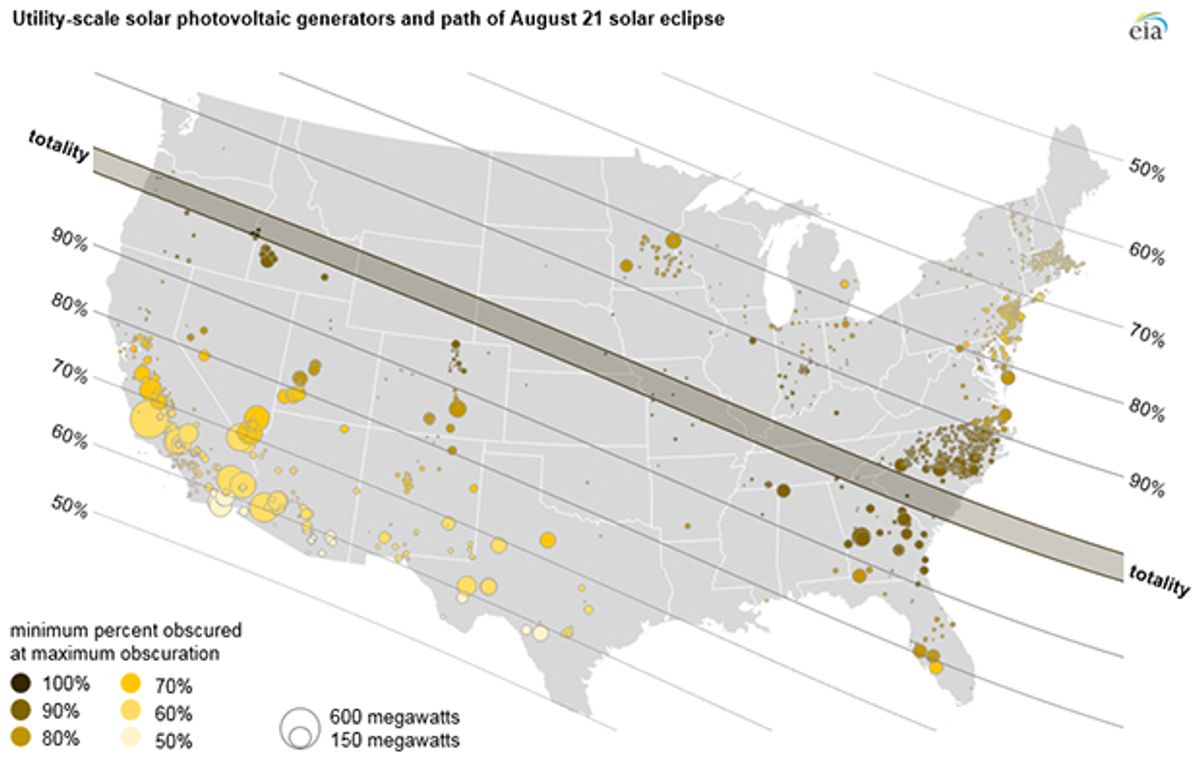Western grid operators such as California’s have become adept at hitting the electricity supply curve balls that weather-dependent wind and solar power toss their way. Today’s eclipse was more like a 105-mph smoker from a predictable fastball pitcher. Grid managers knew exactly when the moon would transit across the sun’s path, blotting out gigawatts of solar power generation. And they could project that, at its worst, the shifts in solar generation would be no more challenging than those experienced already on partly cloudy days.
Kevin Geraghty, senior vice president of energy supply for Nevada utility NV Energy, told the Las Vegas Journal-Review last week that, “We’ll just simply ride through it.” And so they did. By all accounts power systems across the Western Interconnection absorbed the eclipse-induced solar crash and resurgence, keeping electrical systems stable throughout.
California faced the biggest challenge. It is not in the path of totality, but the 56- to 78-percent blockage of sunlight will have a big impact thanks to 18 gigawatts worth of solar panels deployed at utility-scale power plants and across rooftops—more than any other state. California’s Independent System Operator (CAISO), which manages most of the state’s power grid, projected this morning that the eclipse would knock out about 4,300 megawatts (MW) of utility-scale solar and another 1,300 MW of rooftop generation. The utility-scale solar loss, traced on the CAISO website after 9 am Pacific time until the eclipse’s California peak at 10:22 am, was actually 3,400 MW.
Executive Director of System Operations Nancy Traweek told reporters at CAISO’s Fulsom control center that the speed at which solar generation was expected to crash and rebound—up to 70 MW per minute—was something CAISO had contended with on certain days in the past when moving cloud cover overlapped with sunrise or sunset.
CAISO expected to manage the quick loss and return of solar power with its established sources of flexibility. Those include rapidly-adjustable hydroelectric and gas-fired power plants, a regional power market that is purpose-built to balance quick-shifting renewable energy, and a growing capability to store electricity and otherwise shape demand for power in real time.
Still, they were taking no chances. Traweek told IEEE Spectrum that CAISO secured 800 to 1000 MW of reserve power for the three hours affected by the eclipse—way beyond the 350 MW they normally have on hand during those hours.
Some other grid controllers did the same. The Sacramento region’s power supplier, the Sacramento Municipal Utility District, doubled its reserves according to SMUD spokesperson Chris Capra.
By bulking up on reserve power, the California grid operators followed the example of those in Europe, which confronted a near total eclipse two years ago. They came through with flying colors by massively preparing. Transmission lines had been unloaded in advance to accommodate eclipse-induced power swings. Grid operators in heavily solar-equipped Germany spent an extra Euro 3.6 million ($4.25 million) to double the normal amount of reserve power at the ready. And over 4 gigawatts of utility-scale capacity in Italy was ordered to sit out the eclipse.
Europe’s 2015 eclipse knocked out 17 gigawatts of solar power generation across the continent, yet electrical frequency—a measure of the match between supply and demand—remained rock solid. It was at all times within 50 millihertz of Europe’s 50 hertz standard, according to a post-eclipse white paper by the Brussels-based European Network for Transmission System Operators for Electricity.
Utilities in the U.S. are benefitting from a few resources that were unavailable to the Europeans in 2015. One is battery storage, which CAISO said it planned to use to the maximum extent possible. Another is demand response, in which power demand is turned down to reduce strain on the grid.
Nest Technologies told IEEE Spectrum that, as of this morning, roughly 1 million homes across the U.S. equipped with the company’s smart thermostats could help reduce power use by roughly 1,000 megawatts during today’s eclipse. Ben Bixby, Next’s general manager for energy and safety, says they include “some hundreds of thousands” of Nest-equipped homes that have already given their local utilities permission to pre-cool their houses and otherwise reduce power demand during peak demand hours. The others signed up after receiving a notice on their devices over the last week asking them if they wanted to participate in the event.
The place to watch this afternoon is North Carolina. According to the U.S. Energy Information Agency, the southern state has the greatest amount of installed PV capacity in the band that will be at least 90 percent obscured. As of May, it had about 2.8 GW of utility-scale PV installations, or about 13 percent of the national total.
Duke Energy, one of the state’s largest utilities, estimated that its solar supply would drop from about 2.5 GW to 0.2 GW at the height of the eclipse this afternoon.
To manage that drop, and the subsequent rebound, Duke is following Italy’s lead and asking its solar power suppliers to alter their behavior. In Duke’s case, it will be asking solar plants to begin ramping down ahead of the eclipse, thus reducing the rate at which Duke needs to ramp up gas-fired power plants to replace the fading solar power.
As Sammy Roberts, Duke Energy director of system operations, put it, his grid controllers will, “gently press rather than punch the gas pedal.”
Peter Fairley has been tracking energy technologies and their environmental implications globally for over two decades, charting engineering and policy innovations that could slash dependence on fossil fuels and the political forces fighting them. He has been a contributing editor with IEEE Spectrum since 2003.



